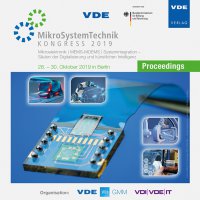PMMA Filled Through-Silicon Vias (TSVs) and Back Etch Process Controlled by Plasma Emission Interferometry
Conference: MikroSystemTechnik 2019 - Kongress
10/28/2019 - 10/30/2019 at Berlin, Deutschland
Proceedings: MikroSystemTechnik 2019
Pages: 4Language: englishTyp: PDF
Personal VDE Members are entitled to a 10% discount on this title
Authors:
Villasmunta, Francesco (Technische Hochschule Wildau, Hochschulring 1, 15745 Wildau, Germany & IHP – Leibniz-Institut für innovative Mikroelektronik, Im Technologiepark 25, 15236 Frankfurt (Oder), Germany & University of Rome ‘Tor Vergata’, Via del Politecnico 1, 00133 Roma, Italy)
Steglich, Patrick; Mai, Andreas (Technische Hochschule Wildau, Hochschulring 1, 15745 Wildau, Germany & IHP – Leibniz-Institut für innovative Mikroelektronik, Im Technologiepark 25, 15236 Frankfurt (Oder), Germany)
Mai, Christian (IHP – Leibniz-Institut für innovative Mikroelektronik, Im Technologiepark 25, 15236 Frankfurt (Oder), Germany)
Heinrich, Friedhelm; Ksianzou, Viachaslau; Schrader, Sigurd (Technische Hochschule Wildau, Hochschulring 1, 15745 Wildau, Germany)
Abstract:
Polymer filling of through-silicon-vias (TSVs) represents a key and challenging procedure for the realization of several microelectronic components in the semiconductor industry with a view to the emerging 3D integration and wafer level packaging technologies. Equally important is, to achieve a complete polymer removal outside the holes without damaging the whole polymer as a precondition for subsequent steps such as encapsulation of the organic components. In the present work, we present first attempts for TSVs filling, using PMMA containing solutions. The polymer removal was realized by means of an inductively coupled O2-plasma, controlled by in-situ optical emission spectroscopy. Confocal Raman spectroscopy has been established to monitor non-destructively the results of the filling process. It is revealed that 750 µm deep TSVs could be filled up to a level of 300 µm below the surface, while the PMMA surface removal process was accurate. The effective and complete filling of the vias requires further investigation.


